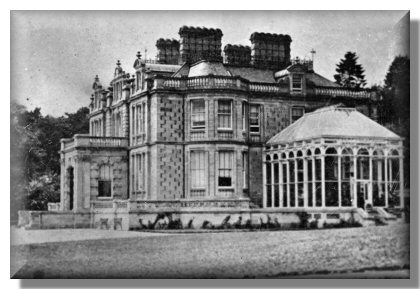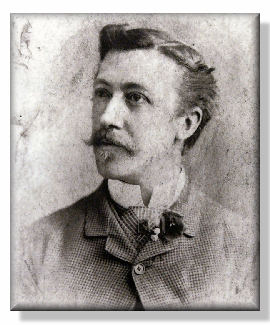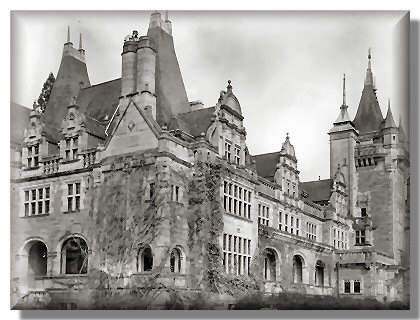
Buy the book! – click here!
Rosehaugh House (above) was a magnificent building on the Rosehaugh estate to the west of Avoch, until demolished in 1959. There has been a house on the grounds since around 1762 – initially a modest L-shaped building, on the lands known by the two names of Pittanochtie and Rosehaugh.
Pittanochtie, which is the older of the two names, is mentioned as early as the 14th century. In the 1660s the lands were acquired by grant by Sir George Mackenzie, the son of Simon Mackenzie of Lochslin Castle, near Tain, brother of the Earl of Seaforth, head of the clan Mackenzie. The Mackenzies between them owned large portions of the eastern seaboard of Ross, and produced several men prominent in political, legal and scholastic circles in the 17th and 18th centuries. George Mackenzie was the most outstanding. Born in Dundee in 1636, he studied at Aberdeen and St. Andrews Universities, and in Bourges. He was admitted to the Scottish Bar in 1656 and had a brilliant legal career, becoming Lord Advocate in 1677. He acquired various lands on the Black Isle, including Pittanochtie, and when knighted in 1674 took the title “Sir George Mackenzie of Rosehaugh” – the name of Rosehaugh apparently being given by Sir George himself.
The first substantial house at the site of Rosehaugh was built in 1790 by Roderick Mackenzie. It is described as follows:
“His seat of Rosehaugh House stands on a beautiful bank about a mile and a half from the sea, on the north side of the southern vale. It is a modern edifice, substantially built and commodious, and cost between £3000 and £4000 sterling” – description in the Old Statistical Account, by the Reverend James Smith, Minister of Avoch.
In 1864 the house and lands were bought by James Fletcher. At this time the estate extended to 6,400 acres. On taking ownership, James immediately embarked on schemes of reclamation and improvement on a massive and expensive scale, attempting and succeeding where no-one would have believed it possible. He drained Loch Scadden, situated above Avoch between Limekilns and Craiglands, and covering almost six acres. The excavation of a 15 foot deep canal through the loch with numerous branch drains on either side successfully drained the area, thereafter leaving the soil to produce the richest of crops. A total of 3300 acres of waste and improvable land was reclaimed, enclosed, drained or planted.

Alexander Ross, the Inverness architect much favoured by James, was commissioned to alter Rosehaugh House, and he added a porch facing south and a conservatory to the east. James died in October 1885, leaving five children. His son, James Douglas Fletcher inherited Rosehaugh House as well as Woolton Hill House in Liverpool. James Douglas, at 28, was a most eligible bachelor and Rosehaugh was a magnificent house by any standards. By 1893 plans had been drawn up for the construction of a mansion house to supercede all others.

William Flockhart was appointed as architect – he had made considerable impact on the architectural scene in Scotland.
“He was an able and brilliant architect; he was moreover, a competent critic, tolerant and broad-minded and a passionate lover of the arts.” – tribute given by the Royal Institute of British Architects
Fletcher had already completed a major refurbishment of the interior of the house by 1893. The house which now faced the architect Flockhart was a four-square, three-bay house. The exterior was in a style very far from Flockhart’s and perhaps his inclination would have been to demolish it and start from scratch. However, it was decided to keep the original house and encase it. Flockhart had a penchant for continually changing things by adding bays in odd places, and changing plans as the building progressed. His other passion was for fine materials and workmanship.




On the death of James Douglas Fletcher, the house was left to his widow, Lilian. She in turn died in 1953, when the house was left to Mrs Fletcher’s niece, Mrs. Shaw-Mackenzie of Newhall. Within a short time everything was sold to the Eagle Star Insurance Company.
Within months of acquiring the ownership of Rosehaugh, the Eagle Star Insurance Company proceeded to release some of the capital invested by selling the contents of the house – it was the largest sale ever staged on the Black Isle, organised by auctioneers Thomas Love and Sons of Perth.

Finally the house was demolished in 1959. The picture above shows shows the site of the house now.
